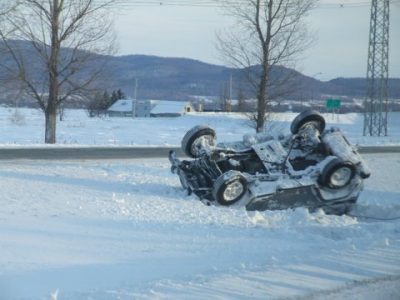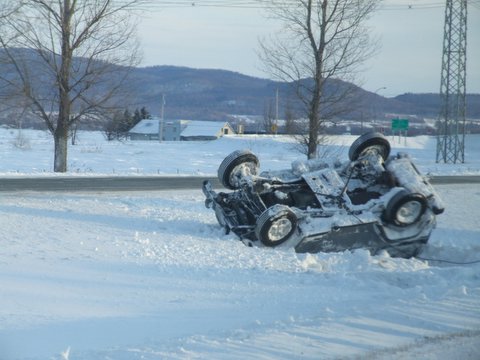 Rollovers are among the scariest and deadliest accidents that occur on the road. While rollovers are not necessarily common (accounting for a little less than 3 percent of car crashes), they are deadly (about 35% of car crash fatalities happen in rollovers). In 2010, more than 7,600 people died in rollover crashes, most of whom were not wearing seat belts. How do rollovers happen? How can we avoid them? What are car companies doing to make cars safer? These are all important questions, the answers to which we will explore below.
Rollovers are among the scariest and deadliest accidents that occur on the road. While rollovers are not necessarily common (accounting for a little less than 3 percent of car crashes), they are deadly (about 35% of car crash fatalities happen in rollovers). In 2010, more than 7,600 people died in rollover crashes, most of whom were not wearing seat belts. How do rollovers happen? How can we avoid them? What are car companies doing to make cars safer? These are all important questions, the answers to which we will explore below.
Table of Contents
How Rollovers Occur
Although any vehicle can end up in a rollover crash, taller and narrower vehicles like SUVs, trucks, vans, and vehicles with high lifts are more likely to flip than other cars because they have a higher center of gravity. The required circumstances for rollovers to occur vary according to speed, direction, terrain, and involvement of other vehicles. Sharp turns can flip vehicles as quickly as collisions can. Other major factors include:
1.) Speed
Speed causes more fatalities in rollover crashes than in non-rollover crash fatalities. According to the National Highway Transportation Safety Administration (NHTSA), about 40% of rollover fatalities in 2010 involved excessive speeding. It is important to note, however, that cars do not have to be going very fast to flip.
2.) Road Obstructions or “Trips”
Though the number is disputed, the Federal Government estimates that about 95 percent of rollovers are caused by single car “trips.” Trips refer to single-car situations. For example, cars traveling on a steep incline, sliding on a slippery surface, or hitting an obstacle other than another car.
3.) Alcohol
Don’t drink and drive. You have heard that phrase since elementary school. And yet, surprisingly, half of all rollover crashes involve intoxicated drivers.
4.) Location
Rural areas, freeways and highways are the most common locations for rollover accidents. About 75% of fatal rollover crashes occur in areas where the speed limit is 55 mph or higher.
5.) Tire Wear and Weather Conditions
How much a tire is worn (or even if the tire “grips” the road too much) and how slippery the road surface is can also be significant factor in causing a rollover crash.
Perhaps most concerning about the causes is that rollover crashes have a lot to do with how a person drives. The NHTSA estimates that nearly 85% of all rollover-related fatalities are the result of single-vehicle crashes and that 90% were caused while a driver was driving “normally,” or performing routine driving techniques. This means that the majority of rollover crashes and fatalities do not involve any other vehicle besides the one that rolled over, and that crashes often occur because a driver is distracted, intoxicated, fatigued, or otherwise impaired.
Preventing Rollovers
Car Manufacturers
Car makers try to prevent rollovers by making tires less “grippy.” They are constantly improving the safety features in vehicles. As of 2012, all cars are required to have Electronic Stability Control (ESC), which is a computerized technology that recognizes when a car is has lost traction and immediately applies the brakes in order to stabilize the vehicle. Car manufacturers are also constantly strengthening the roof of vehicles to lower the risk of drivers being ejected and protecting the passengers from being crushed if the car rolls over. NHTSA estimates that caved-in car roofs kill about 600 and injure about 900 people every year.
NHTSA
Beginning in 2004, he NHTSA developed a Five Star Rating system that includes an on-road dynamic crash course test that keeps consumers informed about rollover safety and rates how safe cars are above and beyond general federal safety regulations. The government combines a crash course test score with a mathematical probability score to come up with an overall rollover rating. The more stars a car receives, the “safer” it is considered to be. For more information, visit safecar.gov.
IIHS
In 2009, the Insurance Institute for Highway Safety (IIHS) introduced its own roof-crush test that subjects a vehicle’s roof to four times the vehicle’s weight. Given the high profile of IIHS, the Institute’s test will undoubtedly influence manufacturers to engineer vehicles that meet those requirements.
New Technology
Auto safety continues to improve as computer technology allows for warning and quick response systems that help drivers prevent accidents from happening and protects them once they have been in an accident. Some of the newest technology includes the following:
- Forward Collision Avoidance Mitigation—detects an impending collision and automatically applies brakes and issues warnings to help drivers avoid crashes.
- Lane Departure Warning (LDW)—uses camera technology to gauge a car’s relation to the lane it is in and warns the driver of unanticipated lane changes so the driver can react and get back into the middle of the lane.
- Frontal Pedestrian Impact Mitigation Braking—warns drivers of impending impact with a pedestrian and applies the brakes automatically if the driver does not do so.
- Automatic Crash Notification (ACN)—automatically notifies emergency personnel when it detects a crash, providing the location.
- Rearview Video System—uses camera technology to show the driver what is in the rear of the vehicle and warns of obstacles that might be in the way.
What You Can Do to Prevent and Survive Rollovers
Wear a seatbelt. Seat belts help keep you in the seat and stabilized in a rollover crash. Fatalities are dramatically more likely when a passenger is flung out of a vehicle. In any crash (not just rollovers) 75% of passengers who are ejected from their vehicles die.
Check your tires. People generally do not check their tires often enough. It is important to not only check the air pressure to be sure they are properly inflated, but to also check the treads on your tires. It is recommended that you check the tire pressure at least once a month and you should maintain them as often as the manufacturer recommends. When you replace them, replace them with similar tires to the original set.
Do not overload your vehicle. Overloading any vehicle, particularly SUVs and pickups, makes the vehicle less stable and more top-heavy. Do overload the top of your vehicle. Keep heavy items on the floor and away from the tailgate, as close to the center of the vehicle as you can.
Follow the speed limit. Speeding not only makes a car more likely to rollover if it hits something, but it also limits your control over the vehicle. Overcorrecting or otherwise reacting due to speeding can also cause rollovers.
Be careful in rural areas or on unfamiliar roads. Watch for animals or other obstacles on the road. These roads can be less-maintained than others, can have unexpected turns, or can be narrower than you expect.
The Insurance Institute for Highway Safety (IIHS) has said that rollover fatality rates continue to drop. Among newer cars (1 to 3 years old), the death rate dropped from 27 in 2000 to 6 in 2012, even as the number of SUVs and cars on the road have increased in general. In short, the survival rate continues to get better.
Common Sense: The Best Prevention
The best defense against rollover accidents is common sense. Be prepared by obeying traffic laws, wear your seatbelt, be wary of road and weather conditions, and anticipate the movements of cars around you. Though not all rollovers can be prevented, you can do much to keep yourself, your family, and others safe while on the road.
Additional Sources: Consumer Reports, IIHS
